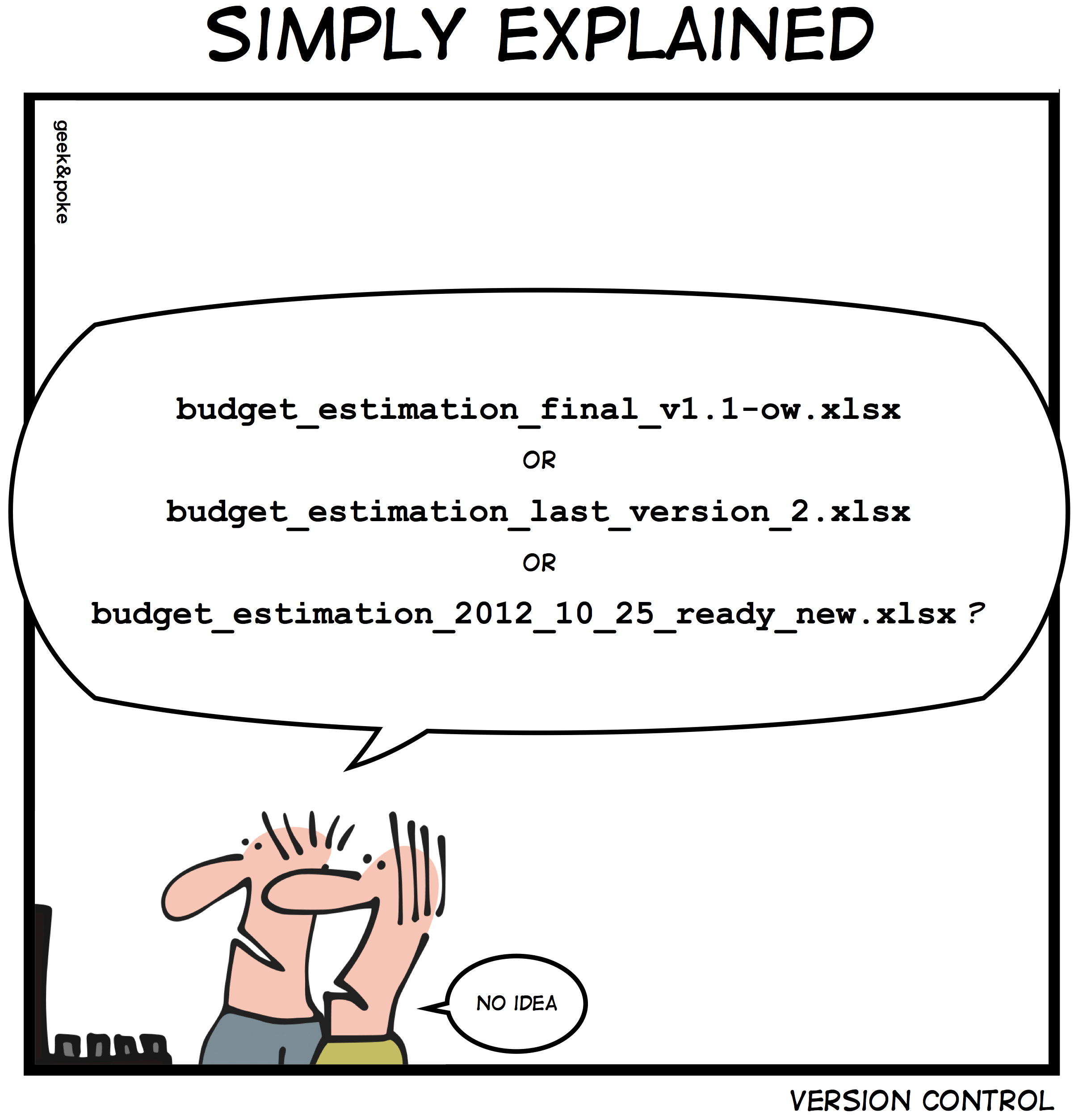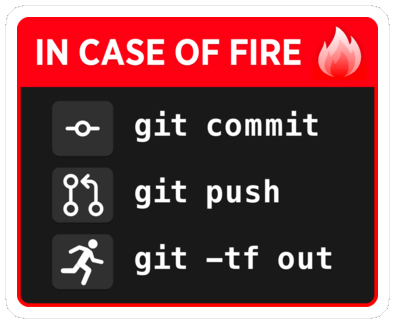Git & GitHub
Effective Versioning & Teamwork

Why Git?
Why version control?

Why version control?

Which version control system?


Which version control system?

Git configuration
User identity
git config --global user.name "<Your Name>"
git config --global user.email "<your@email>"Example
git config --global user.name "John Doe"
git config --global user.email "john.doe@gmail.com"Text editor
git config --global core.editor "<text-editor>"Example for nano
git config --global core.editor "nano"Line ending
macOS, Linux, or WSL
git config --global core.autocrlf inputWindows
git config --global core.autocrlf trueList settings
git config --listDocumentation
Internal documentation
Man pages
git <command> --help
git help <command>
man git-<command>Example
git commit --help
git help commit
man git-commitInternal documentation
Man pages
git <command> --help
git help <command>
man git-<command>Useful keybindings when you are in the pager
SPACE scroll one screen down
b scroll one screen up
q quitInternal documentation
Command options
git <command> -hExample
git commit -hOnline documentation
- Official Git manual
- Open source Pro Git book
Courses & workshops
- WestGrid's Git workshops
- last summer WestGrid Git course
- last fall WestGrid Git course
- the Software Carpentry Git lesson
Q & A
Understanding Git
Project history
Git saves the history of a project as a series of snapshots

Project history
Those snapshots are called commits

Project history
Commits are identified by unique hash

Project history
Each commit contains these metadata: - author - date and time - the hash of parent commit(s) - a message
Project history
As soon as you create the first commit, a pointer called a branch is created and it points to that commit. By default, that first branch is called main

Project history
Another pointed (HEAD) points to the branch main
HEAD indicates where we are in the project history

Recording history
As you create more commits, the history grows …

Recording history
… and the pointers HEAD and main automatically move to the last commit

Recording history
For simplicity, the diagrams can be simplified this way

Displaying the commit history
As a list
git log --onelineDisplaying the commit history
Making it more readable
git log \
--graph \
--date-order \
--date=short \
--pretty=format:'%C(cyan)%h %C(blue)%ar %C(auto)%d'`
`'%C(yellow)%s%+b %C(magenta)%ae'Displaying the commit history
As a graph
git log --graphDisplaying the commit history
As a graph showing all commits
git log --graph --allHow does Git work?
The three trees of Git
A useful representation of Git’s functioning is to imagine three file trees

Making changes to the working tree
When you work on your project, your working tree changes

Staging changes
You organize your next snapshot by picking and choosing some changes
git add <what-you-want-to-commit-next>Staging changes
Those changes move to the index or staging area

Creating a commit
Finally you create a commit with what is in the staging area
git commit -m "<message>"Creating a commit
Finally you create a commit with what is in the staging area

Remotes
What are remotes?
Copies of a project & its history
Anywhere, including on external drive or on the same machine as the project
Often on a different machine to serve as backup or on a network (e.g. internet) to serve as syncing hub for collaborations
Popular online Git repository managers & hosting services:
Collaboration
3 situations
You create a project on your machine & want others to contribute to it (1)
You want to contribute to a project started by others & …
… you have write access to it (2)
… you do not have write access to it (3)
(1) You start the project
Create a remote on GitHub
1. Create an empty repository on GitHub
Go to https://github.com , login, & go to your home page
Look for the Repositories tab & click the green New button
Enter the name you want for your repo, without spaces
Make the repository public or private
Create a remote on GitHub
2. Link empty repository to your repo
Click on the Code green drop-down button, select SSH if you have set SSH for your GitHub account or HTTPS & copy the address
In command line, cd inside your project & add the remote
git remote add <remote-name> <remote-address><remote-name>
is a convenience name to identify that remote. You can choose any name, but since Git automatically call the remote origin when you clone a repo, it is common practice to use origin as the name for the first remote
Create a remote on GitHub
git remote add origin git@github.com:<user>/<repo>.gitgit remote add origin https://github.com/<user>/<repo>.gitCreate a remote on GitHub
If you are working alone on this project & only wanted to have a remote for backup, you are set
If you don’t want to grant others write access to the project & only accept contributions through pull requests, you are also set
If you want to grant your collaborators write access to the project however, you need to add them to it
Invite collaborators
- Go to your GitHub project page
- Click on the Settings tab
- Click on the Manage access section on the left-hand side (you will be prompted for your GitHub password)
- Click on the Invite a collaborator green button
- Invite your collaborators with one of their GitHub user name, their email address, or their full name
(2) Write access to project
Clone project
cd to location where you want your local copy, then
git clone <remote-address> <local-name>This sets the project as a remote to your new local copy & that remote is automatically called origin
Without <local-name>, the repo will have the name of the last part of the remote address
(3) No write access to project
Collaborate without write access
Fork the project
Clone your fork on your machine
Add the initial project as a second remote & call it
upstream
Working with remotes
Get information on remotes
List remotes:
git remoteList remotes with their addresses:
git remote -vGet information on remotes
Get more information on a remote:
git remote show <remote-name>git remote show originManage remotes
Rename a remote:
git remote rename <old-remote-name> <new-remote-name>Delete a remote:
git remote remove <remote-name>Change the address of a remote:
git remote set-url <remote-name> <new-url> [<old-url>]Get data from a remote
If you collaborate on a project, you have to get the data added by your teammates to keep your local project up to date
To download new data from a remote, you have 2 options:
git fetchgit pull
Fetch changes
Fetching downloads the data from a remote that you don’t already have in your local version of the project
git fetch <remote-name>The branches on the remote are now accessible locally as <remote-name>/<branch>. You can inspect them or you can merge them into your local branches
git fetch originPull changes
Pulling fetches the changes & merges them onto your local branches
git pull <remote-name> <branch>git pull origin mainIf your branch is already tracking a remote branch, you can omit the arguments
git pullPush to a remote
Uploading data to the remote is called pushing
git push <remote-name> <branch-name>git push origin mainPush to a remote
You can set an upstream branch to track a local branch with the -u flag
git push -u <remote-name> <branch-name>git push -u origin mainFrom now on, all you have to run when you are on main is:
git pushSubmit a pull request
- Pull from
upstreamto update your local project - Create & checkout a new branch
- Make & commit your changes on that branch
- Push that branch to your fork (i.e.
origin— remember that you do not have write access toupstream) - Go to the original project GitHub’s page & open a pull request
Questions?
